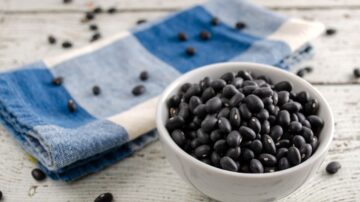The Qur’an (7:160) says, “Eat of the good foods We have provided for you.” The question may arise: if Allah has provided us with so many good foods, why are so many people starving and many more suffering from malnutrition? The answer may lie in our ignorance of the abundance that has been sent to us by Allah.
We have been blessed with many “miracle foods” that provide us with incredible amounts of concentrated nutrition and healing and are also affordable. Many of these foods can be grown or found in any environment. The modern market, however, is marketing many of them as “super foods,” and in the process, charging many times their actual costs, which creates the illusion that healthy eating is expensive.
On the other hand, there are agencies that are exploring the possibility of providing some of these “super foods” to supply nutrition to poverty stricken areas of the world.
The Qur’an hints at some of these secrets when it says, “It is he who has made the sea subject… that ye may seek (thus) of the bounty of Allah” (10:14), and “From within their bodies, a drink of varying colors comes. Wherein is healing for me: Verily this is a sign for those who give thought” (16:69).
In fact, most super foods are readily found in nature and require minimal planting or harvesting. Some of the most readily available are bee pollen, spirulina (algae), kelp, royal jelly, honey, wheat grass, flax seeds, and alfalfa and other sprouts. Among herbs that have been taken as sustenance foods is marshmallow root, used by the Chinese, Assyrians, Egyptians, and Greeks in times of famine.
These “miracle foods” are readily available sources of food for countries that are plagued by famine and malnutrition, and they can be used to give a nutritional boost to people who have adequate nutrition, are fasting, or are suffering from a chronic illness. Many, such as bee pollen and algae, are used across species lines so we are not inventing the idea of super foods – we are simply rediscovering them.
It is best to consume super foods regularly, to self-harvest them, or to buy them from a reputable source that does not alter them by extracting substances from them or adding to them (e.g., by making them into a health drink with fructose and other additives). The following is a list of some “miracle foods”:
1. Spirulina (Blue Green Algae): Blue Green Algae is the superior form of spirulina; however, they are both essentially the same thing – algae that survives in hot sunny climates and is thought by many to be the solution to world hunger. Algae produce twenty times as much protein as soybeans. Furthermore, it contains many nutrients not found in any other single food source such as gamma-linoleic acid, vitamin B-12, iron, essential amino acids, chlorophyll, RNA, DNA, and phycocyanin (a substance that has increased the life span in lab rats). Algae curb the appetite, reduce cholesterol levels, and aid in mineral absorption. You can harvest it at any natural water source (within specific guidelines only – not all algae is edible) or you can buy it in capsule or powder form.
2. Kelp: Kelp is another type of seaweed and can be eaten raw, cooked, whole or chopped. It comes as a liquid, powder or dried. Used as a salt substitute to provide iodine as well as sodium, it contains many minerals and vitamins in concentrate, especially B vitamins. It is beneficial to brain tissue, sensory nerves, the skin, nails, and blood vessels.
3. Honey: Comprised of 35% protein and containing half of all the amino acids the body needs, honey also has many other essential nutrients such as B-complex and vitamins C, D and E.
4. Bee-Pollen: The powder produced by the anthers of flowers and collected by bees, bee pollen contains 15% protein, B-complex vitamins, vitamin C, amino acids, essential fatty acids, enzymes, carotene, calcium, copper, iron, magnesium, potassium, and plant sterols. It has an anti-microbial effect on the body and strengthens the immune system.
5. Royal Jelly: A combination of honey and pollen that is refined inside the nurse bee and secreted, this substance provides the benefits of both pollen and honey plus a high concentration of pantothenic acid (vitamin B).
6. Wheat Grass: Research shows that one pound of wheat grass is equal in nutrients and vitamin content to twenty-five pounds of choice vegetables. It is a living food that provides a powerhouse of nutrition available to all, and it helps in the elimination of cancerous growths. Produced by sprouting wheat berries, one of the cheapest grains on the market, wheat grass can be grown easily on trays with a little water in only three days time from “planting” to “harvest.” Whole-wheat berries (before they become flour) are sold for about 15 cents a pound. Twenty-five pounds worth of wheat berries could supply a family with meals for almost a year.
7. Alfalfa: Often used for livestock, alfalfa’s benefits for human consumption are largely ignored. In fact, in some areas, valuable alfalfa is fed to livestock while neighboring people search for nutrition in their own food. Its roots, which grow nearly 10 feet underground, may account for the fact that it is one of the most mineral-dense foods around. It contains ALL of the known vitamins and most minerals such as calcium, magnesium, phosphorus, potassium, and chlorophyll.
Allah has provided us with many more “miracle foods.” Many of the tonic herbs fall into this category as well as many fruits such as acerola berries, and vegetables such as sprouts. Everyone should partake of these miracle foods, easily found or cultivated throughout the earth, that Allah has sent us for nutrition and healing. The Qur’an (94:5) says, “Verily, with every difficulty there is relief.”
By Karima Burns

